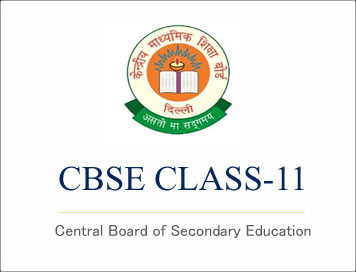CBSE Class-11 Syllabus 2018-19 (Physics)
Disclaimer: This website is NOT associated with CBSE, for official website of CBSE visit - www.cbse.gov.in
CBSE Class-11 Syllabus 2018-19 (Physics)
Senior Secondary stage of school education is a stage of transition from general education to discipline-based focus on curriculum. The present updated syllabus keeps in view the rigour and depth of disciplinary approach as well as the comprehension level of learners. Due care has also been taken that the syllabus is comparable to the international standards. Salient features of the syllabus include:
- Emphasis on basic conceptual understanding of the content.
- Emphasis on use of SI units, symbols, nomenclature of physical quantities and formulations as per international standards.
- Providing logical sequencing of units of the subject matter and proper placement of concepts with their linkage for better learning.
- Reducing the curriculum load by eliminating overlapping of concepts/content within the discipline and other disciplines.
- Promotion of process-skills, problem-solving abilities and applications of Physics concepts.Besides, the syllabus also attempts to
- strengthen the concepts developed at the secondary stage to provide firm foundation for further learning in the subject.
- expose the learners to different processes used in Physics-related industrial and technological applications.
- develop process-skills and experimental, observational, manipulative, decision making and investigatory skills in the learners.
- promote problem solving abilities and creative thinking in learners.
- develop conceptual competence in the learners and make them realize and appreciate the interface of Physics with other disciplines.
Unit I: Physical World and Measurement 10 Periods
Chapter–1: Physical World
Physics-scope and excitement; nature of physical laws; Physics, technology and society.
Chapter–2: Units and Measurements
Need for measurement: Units of measurement; systems of units; SI units, fundamental and derived units. Length, mass and time measurements; accuracy and precision of measuring instruments; errors in measurement; significant figures.Dimensions of physical quantities, dimensional analysis and its applications.
Unit II: Kinematics 20 Periods
Chapter–3: Motion in a Straight Line
Frame of reference, Motion in a straight line: Position-time graph, speed and velocity.
Elementary concepts of differentiation and integration for describing motion, uniform and non-uniform motion, average speed and instantaneous velocity, uniformly accelerated motion, velocity - time and position-time graphs.
Relations for uniformly accelerated motion (graphical treatment).
Chapter–4: Motion in a Plane
Scalar and vector quantities; position and displacement vectors, general vectors and their notations; equality of vectors, multiplication of vectors by a real number; addition and subtraction of vectors, relative velocity, Unit vector; resolution of a vector in a plane, rectangular components, Scalar and Vector product of vectors.
Motion in a plane, cases of uniform velocity and uniform acceleration-projectile motion, uniform circular motion.
Unit III: Laws of Motion 14 Periods
Chapter–5: Laws of Motion
Intuitive concept of force, Inertia, Newton's first law of motion; momentum and Newton's second law of motion; impulse; Newton's third law of motion.
Law of conservation of linear momentum and its applications.
Equilibrium of concurrent forces, Static and kinetic friction, laws of friction, rolling friction, lubrication.
Dynamics of uniform circular motion: Centripetal force, examples of circular motion (vehicle on a level circular road, vehicle on a banked road).
Unit IV: Work, Energy and Power 12 Periods
Chapter–6: Work, Engery and Power
Work done by a constant force and a variable force; kinetic energy, work-energy theorem, power.
Notion of potential energy, potential energy of a spring, conservative forces: conservation of mechanical energy (kinetic and potential energies); non-conservative forces: motion in a vertical circle; elastic and inelastic collisions in one and two dimensions.
Unit V: Motion of System of Particles and Rigid Body 18 Periods
Chapter–7: System of Particles and Rotational Motion
Centre of mass of a two-particle system, momentum conservation and centre of mass motion.
Centre of mass of a rigid body; centre of mass of a uniform rod.
Moment of a force, torque, angular momentum, law of conservation of angular momentum and its applications.
Equilibrium of rigid bodies, rigid body rotation and equations of rotational motion, comparison of linear and rotational motions.
Moment of inertia, radius of gyration, values of moments of inertia for simple geometrical objects (no derivation). Statement of parallel and perpendicular axes theorems and their applications.
Unit VI: Gravitation 12 Periods
Chapter–8: Gravitation
Kepler's laws of planetary motion, universal law of gravitation.
Acceleration due to gravity and its variation with altitude and depth.
Gravitational potential energy and gravitational potential, escape velocity, orbital velocity of a satellite, Geo-stationary satellites.
Unit VII: Properties of Bulk Matter 20 Periods
Chapter–9: Mechanical Properties of Solids
Elastic behaviour, Stress-strain relationship, Hooke's law, Young's modulus, bulk modulus, shear modulus of rigidity, Poisson's ratio; elastic energy.
Chapter–10: Mechanical Properties of Fluids
Pressure due to a fluid column; Pascal's law and its applications (hydraulic lift and hydraulic brakes), effect of gravity on fluid pressure.
Viscosity, Stokes' law, terminal velocity, streamline and turbulent flow, critical velocity, Bernoulli's theorem and its applications.
Surface energy and surface tension, angle of contact, excess of pressure across a curved surface, application of surface tension ideas to drops, bubbles and capillary rise.
Chapter–11: Thermal Properties of Matter
Heat, temperature, thermal expansion; thermal expansion of solids, liquids and gases, anomalous expansion of water; specific heat capacity; Cp, Cv - calorimetry; change of state - latent heat capacity.
Heat transfer-conduction, convection and radiation, thermal conductivity, qualitative ideas of Blackbody radiation, Wein's displacement Law, Stefan's law, Green house effect.
Click Here To Download Full Syllabus
Courtesy: CBSE
